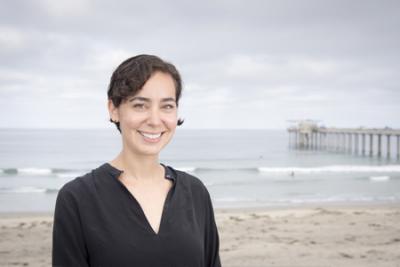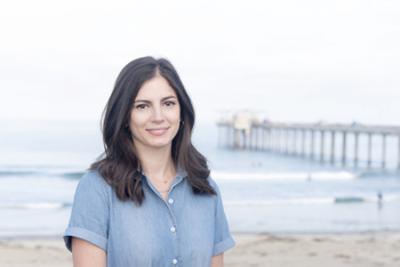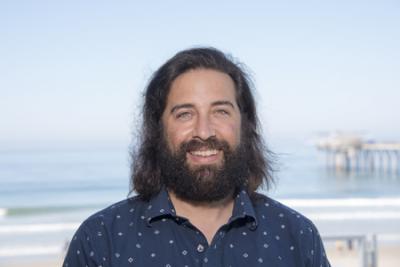Four new faculty members have joined Scripps Institution of Oceanography at the University of California San Diego this academic year. Their diverse research interests range from shark ecology and geochemistry to microbiology and human health, but all are united through UC San Diego’s strategic research initiative of understanding and protecting the planet.
The understanding and protecting the planet theme encourages research, education and outreach focused on environmental change and societal resilience to hazards posed by human-induced climate change.
“Scripps is at the forefront of training the next generation of scientific and environmental leaders because we have top-notch faculty members who inspire and educate these bright students,” said Margaret Leinen, vice chancellor for marine sciences at UC San Diego and director of Scripps Institution of Oceanography. “These new faculty appointments support our interdisciplinary efforts to find solutions to our greatest environmental challenges, ranging from climate change to the health of the ocean and its smallest inhabitants.”
Over the past several years, education offerings at Scripps have expanded to accommodate a growing number of students ranging from undergraduate through graduate level. The undergraduate program has seen the most growth in recent years, now offering four majors including oceanic and atmospheric sciences—which was added in 2018—and four minors including climate change studies, the most recent offering added in 2019.
Sarah Aarons

Sarah Aarons is an assistant professor in the Geosciences Research Division at Scripps. Aarons is an isotope geochemist whose research is primarily focused on understanding the evolution of Earth’s surface through time as a function of a changing climate. Her research involves measurement of isotope compositions of natural materials such as mineral dust, weathering profiles, river sediment, and ancient rocks. The majority of her research is concentrated on mineral dust, fine grained sediment that is blown up into the atmosphere and transported thousands of miles before it’s deposited in glaciers, ice sheets, and terrestrial ecosystems. Her projects include tracing dust transport during large scale climate transitions, probing the ecological significance of modern dust, and quantifying changes in nutrient fluxes due to glacial retreat. Her work involves field campaigns in Antarctica, Alaska, and California, clean lab chemistry, and mass spectrometry. She comes to Scripps from the University of Chicago, where she completed a postdoctoral fellowship. Aarons holds an MS and PhD in Earth and environmental science from the University of Michigan and a BS in geological and environmental science from Stanford University.
“I am very happy to be surrounded by colleagues and students working in such cross-disciplinary and diverse fields here at Scripps, and I’m looking forward to future collaborations,” said Aarons.
Julia Diaz

Julia Diaz is an assistant professor in the Geosciences Research Division at Scripps. Diaz is a biogeochemist whose research explores how the ocean’s smallest inhabitants, such as phytoplankton, interact with their chemical environment to shape the natural world in big ways, including impacts on ecosystem health, natural resources and global climate. The Diaz lab conducts this work using a combination of lab-based experiments with model organisms and field work in diverse ocean settings, from coastal to open ocean environments. Among other projects, the Diaz lab studies how marine phytoplankton cope with stress by obtaining the chemical nutrients they need from seawater, such as phosphorus, and converting chemical elements into forms that can be harmful or beneficial to life, such as reactive oxygen species. As a key part of this work, the Diaz lab is actively discovering new enzymes that drive these biogeochemical cycles. Diaz comes to Scripps from the University of Georgia Skidaway Institute of Oceanography, where she was an assistant professor. Diaz holds a PhD in Earth and atmospheric sciences from the Georgia Institute of Technology as well as a BS in biology from the University of Georgia. She completed her postdoctoral work at Harvard University and the Woods Hole Oceanographic Institution.
“I am so excited to move my lab to Scripps,” said Diaz. “I look forward to seeing my students and postdocs thrive here, to growing my research program, and contributing to the vibrant scientific community.”
Dovi Kacev

Dovi Kacev is an assistant teaching professor in the Marine Biology Research Division at Scripps. Kacev’s research interests are in the field of ecology and marine biology, with a special focus on understanding the ecology of migratory shark species. Previous research by Kacev used molecular techniques to analyze mako and thresher shark (Isurus oxyrinchus and Alopias vulpinus) populations and migration patterns in the Southern California Bight. He hopes to incorporate these findings in future fishery management plans to ensure viable, pelagic shark populations. His recent postdoctoral research with NOAA’s Southwest Fisheries Science Center, where he continues to collaborate, focused on the application of next-generation genetic sequencing techniques to ID the early life stages of fishes and answer questions in fisheries science. At Scripps, most of his time will be spent teaching marine biology and ecology labs and courses, and he will also continue doing active research and field work. Kacev grew up traveling between San Diego and South Africa, where animals and the ocean quickly became his passion. He holds a PhD in ecology from a joint program offered by San Diego State University and UC Davis and a BS in marine biology and economics from UC Los Angeles.
“I am excited to work with the amazing students, faculty, and staff at Scripps and UC San Diego to continue to develop a stellar undergraduate program in marine biology,” said Kacev.

Amina Schartup
Amina Schartup is an assistant professor in the Geosciences Research Division at Scripps. Schartup is a multidisciplinary researcher whose work lies at the intersection of marine biogeochemistry and human health. Schartup uses modeling and experimental tools to understand how mercury cycles in aquatic environments where it converts into its toxic form, methylmercury, which accumulates in fish people like to eat. For example, as a postdoctoral fellow with the Harvard T. H. Chan School of Public Health, Schartup led a four-year project to estimate potential increases in methylmercury exposures for Inuit communities in Labrador, Canada, that surrounded a planned hydroelectric facility. Schartup also develops models to quantify the impacts of global and ecosystem changes on the bioaccumulation of contaminants in marine food webs. Schartup holds a PhD in oceanography from the University of Connecticut, an MSc in geochemistry from the Institut de Physique du Globe de Paris, and a BSc in chemistry from Paris Descartes University.
“Scripps is a beautiful institution full of great minds," said Schartup. "I cannot wait to exchange ideas and work with my new colleagues, watch the students grow into world-class scientists, and learn to surf!”
Last academic year, Scripps welcomed three new faculty members to campus: Assistant Professor Anela Choy, a marine ecologist who studies the structure and function of open ocean and deep-sea food webs; Professor Jack Gilbert, a microbial ecologist with a joint appointment between Scripps and the Department of Pediatrics at UC San Diego who studies the human microbiome and the microbial ecology of natural and built environments; and Assistant Professor Ross Parnell-Turner, a geophysicist whose research concerns how the lithosphere is created and deformed, using geophysical and geological observations made in the oceans.
About Scripps Oceanography
Scripps Institution of Oceanography at the University of California San Diego is one of the world’s most important centers for global earth science research and education. In its second century of discovery, Scripps scientists work to understand and protect the planet, and investigate our oceans, Earth, and atmosphere to find solutions to our greatest environmental challenges. Scripps offers unparalleled education and training for the next generation of scientific and environmental leaders through its undergraduate, master’s and doctoral programs. The institution also operates a fleet of four oceanographic research vessels, and is home to Birch Aquarium at Scripps, the public exploration center that welcomes 500,000 visitors each year.
About UC San Diego
At the University of California San Diego, we embrace a culture of exploration and experimentation. Established in 1960, UC San Diego has been shaped by exceptional scholars who aren’t afraid to look deeper, challenge expectations and redefine conventional wisdom. As one of the top 15 research universities in the world, we are driving innovation and change to advance society, propel economic growth and make our world a better place. Learn more at ucsd.edu.



